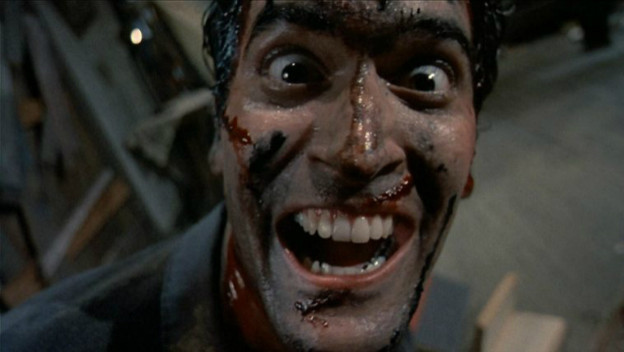DOOM is a violent-ass video game. It is all about motion: never stop moving, shooting, stabbing, killing, ripping and tearing, and eso on. But it’s also about having a good time and laughing. Everything, from the very beginning when the DOOM Marine is literally summoned to life in a sci-fi/satantic hybrid ritual to the ridiculous-but-not-entirely-unrealistic corporate propaganda all over the place, is meant to put a smile on the player’s face. It revels in itself on all levels, including being as self-indulgent as it possibly can when it comes to the gooey stuff, as the player imposes themselves upon the demon army. But the violence, according to the creators, isn’t about being shocking, or scary or adult. It’s actually about lightening the mood.
We’re in a weird place right now in pop culture and nerd-friendly media. As consumers, we seem to be obsessed with themes of maturity and adulthood, which are often interpreted in ways meant to shock or titillate the viewer. Game of Thrones and The Walking Dead are full of moments meant to make anyone watching cartoonishly uncomfortable, to keep their eyes glued to the screen, to toy with their expectations, and keep them watching next week. Characters scientifically designed to be relatable or sympathetic are brutalized, raped, and murdered, often to the detriment of the storytelling and pathos of the material. But it sure was a surprise, right?
Arguably, this brand of adult storytelling isn’t really adult at all. But violence does have its place in media, as it does in real life and as it does in actually well-done and effective storytelling. What is adult is nuance, acknowledging how complicated life can be, and how defying expectations isn’t always about upsetting people. Sometimes it’s just as subversive to add some color to a situation and make someone laugh. That’s exactly what DOOM did, and that’s exactly why so many articles were written praising its ostensibly simple storytelling.
In a recent interview with GamesIndustry.biz , DOOM ’s Creative Director Hugo Martin said, “We were going for smiles, not shrieks. What we found with violence is that more actually makes it safer, I guess, or just more acceptable. It pushes it more into the fun zone. Because if it’s a slow trickle of blood out of a slit wrist, that’s Saw . That’s a little bit unsettling, and sort of a different type of horror. If it’s a comical fountain of Hawaiian Punch-looking blood out of someone’s head that you just shot off, that’s comic book. That’s cartoonish, and that’s what we wanted.”

Being willing to take something to an outlandish, campy extreme, especially in today’s pop culture climate, is almost more subversive than anything anyone else is currently doing. We’re not talking a toothless, corporate “bad on purpose” joint like a Sharknado or a project with a tongue practically boring a hole in it’s cheek. DOOM is earnest, and still interesting in bringing something valuable and meaningful to the table, just without the hamfisted irony or pretense of its peers. It’s more along the lines of an Evil Dead 2 , or a Tucker and Dale vs Evil .
Exploring themes of violence in a more colorful light, combined with an almost metatextual introspection on what “ DOOM ” really means to both its fans and creators is what made that game stand out. DOOM is really special, not only put the brand back in the spotlight, but also made people think about what games can do with regards to nuance in adult-oriented stories. You can have frowning, violence, and attitude without everything being tragic, dour, and oppressive all the time. You can respect the intelligence of your audience without needing to constantly shock them for attention. It’s okay to toss a banana peel in front of that pool of blood – humor can be profound in its own way too.
